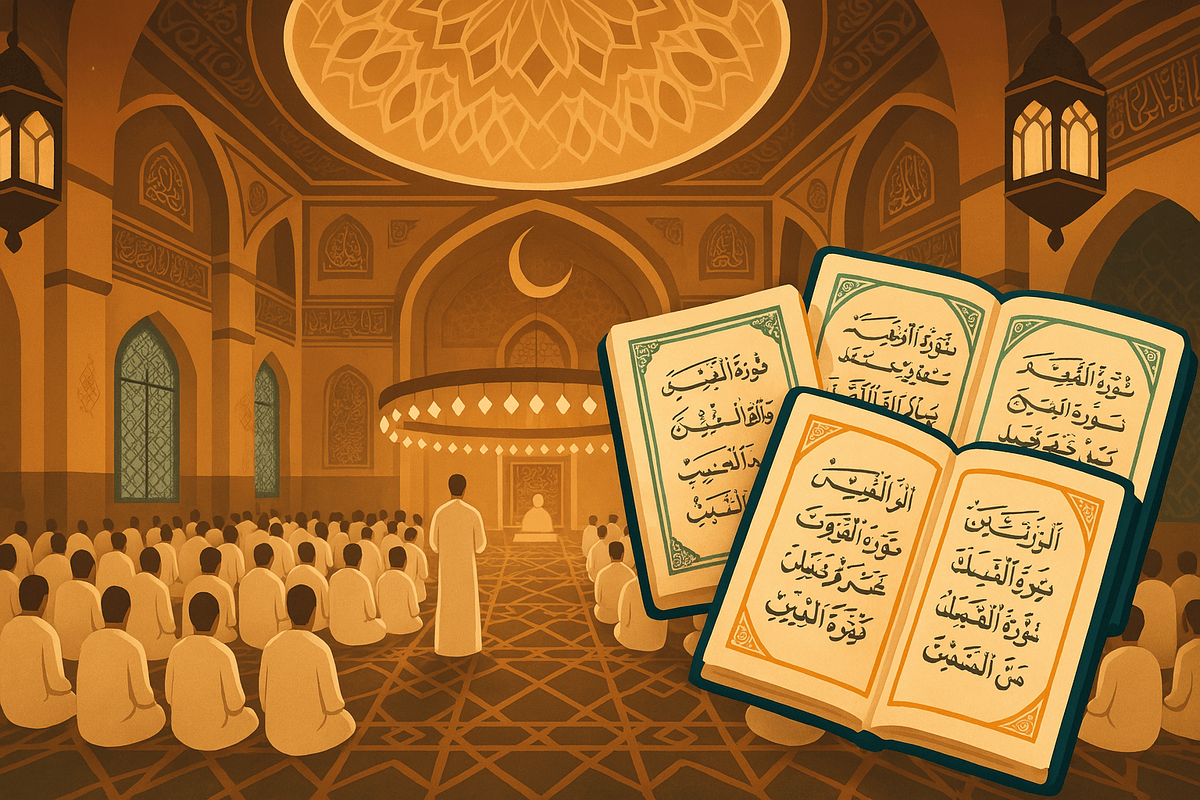The blessed occasions of Eid al-Fitr and Eid al-Adha are moments of great joy and gratitude for Muslims around the world. These days are marked by acts of worship, community gathering, and heartfelt supplications to Allāh. Among the beautiful practices of these days is the performance of the Eid prayer, a Sunnah Mu’akkadah (emphasised Sunnah) that was regularly observed by the Prophet Muḥammad (ﷺ) and his companions. As part of this special prayer, the Prophet (ﷺ) demonstrated specific guidance regarding the recitation of particular Surahs, adding further beauty and significance to the worship.
The Prophet Muhammad (ﷺ) established the practice of reciting specific Surahs during Eid prayers, emphasising their importance and spiritual benefits. On Eid al-Fitr and Eid al-Adha, it is Sunnah to recite Surah Al-A'la and Surah Al-Ghashiyah, or Surah Qaf and Surah Al-Qamar, reflecting a tradition of beauty, remembrance, and guidance.

Reciting the Sunnah Surahs for Eid prayers as taught by the Prophet ﷺ.
Authentic narrations establish that the Prophet (ﷺ) would recite Sūrah Al-A‘lā (الأعلى) and Sūrah Al-Ghāshiyah (الغاشية) during the Eid prayers. In one narration reported by An-Nu’man ibn Bashir (رضي الله عنه), it is mentioned that the Messenger of Allāh (ﷺ) would recite these Surahs on the two Eid days and also during Jumu’ah prayers. The recitation of these Surahs, with their profound messages and rhythmic beauty, brings forth a sense of humility and mindfulness of the Hereafter. Sūrah Al-A‘lā, with its praise of Allāh’s creation and guidance, followed by Sūrah Al-Ghāshiyah’s vivid description of the Last Day, serves as a powerful reminder of Allāh’s authority and mercy.
Another Sunnah recitation for the Eid prayers includes Sūrah Qāf (ق) and Sūrah Al-Qamar (القمر). ‘Umar ibn Al-Khattāb (رضي الله عنه) narrated that the Prophet (ﷺ) would recite these Surahs on Eid day and on Fridays. These chapters, marked by their eloquence and warning against heedlessness, were often recited by the Prophet (ﷺ) to deliver strong reminders to the believers. The imagery of resurrection and accountability in these Surahs carries a message of awakening, prompting the believer to reflect upon their deeds and seek the pleasure of Allāh.
The placement of these Surahs in the two Rak‘āt of Eid prayer has also been indicated through the practice of the Prophet (ﷺ). He would commonly recite Sūrah Al-A‘lā or Sūrah Qāf in the first Rak‘ah, followed by Sūrah Al-Ghāshiyah or Sūrah Al-Qamar in the second Rak‘ah. This arrangement allows the worshipper to ponder over the themes of gratitude, divine guidance, resurrection, and accountability during these joyous prayers. The recitation of these Surahs serves not only as a spiritual experience but also as an opportunity for deep reflection and personal growth.
“Those to whom We have given the Scripture and they recite it observing the rights of its recitation – those are the ones who (truly) believe in it. Those who disbelieve in it (by not observing its rights), those are the losers.” (al-Baqarah: 121)
Muslims around the world continue to follow this Sunnah, striving to emulate the practice of the Prophet (ﷺ) in their Eid prayers. Reciting these Surahs with proper reflection and devotion enhances the connection with Allāh, making the Eid prayer a moment of both celebration and sincere worship. As believers gather for the Eid Salah, the recitation of these Surahs serves as a unifying act of remembrance, drawing hearts closer to the teachings of the Messenger (ﷺ) and the guidance of the Qur’ān.
Join our mailing list!
Subscribe to our newsletter and be the first to receive our latest articles, insights, and updates straight to your inbox.